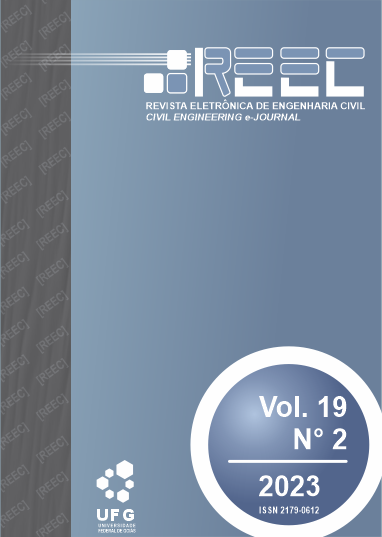Feasibility study for use of the Constructive Method Insulated Concrete Forms (ICF), for the Execution of a Building in the Northwest Region of the State of Rio Grande do Sul Through the Constructive System of Self-Supporting Reinforced Concrete Walls
DOI:
https://doi.org/10.5216/reec.v19i2.77734Keywords:
Insulated Concrete Forms, Modular Construction, Thermoacoustic Formwork in EPS, Innovative Construction, Modular TechnologyAbstract
Seeking to expand knowledge about more effective construction systems and methods, valuing sustainability, offering benefits such as productivity, financial savings and reduction of waste from construction, but mainly, thermal and acoustic comfort, the Insulated Concrete construction methodology was identified on the market. Forms (ICF), employed by the company ARXX Brasil. This methodology, originally American, is adopted in the concrete wall construction system, which in turn allows the execution of self-supporting buildings, providing high levels of thermal and acoustic conformity. The molds used in the construction of the walls are manufactured in EPS (Expanded Polystyrene), with their faces fixed using components called “fingers”, which are considered in the structural calculation of the wall. The walls are easily assembled, like Lego pieces, which fit together using male-female fittings. From this context, the present study focused on presenting this innovative methodology, demonstrating its applicability through a comparative study with the conventional construction system, widely used in Brazil. From this, significant results were obtained that demonstrate that the ARXX ICF methodology is the most viable to be used, especially in regions where the seasons are well defined, such as the states located in the southern region of Brazil.
Downloads
References
ABRELPE. Panorama dos Resíduos Sólidos no Brasil – 2.8 Resíduos de construção e demolição (RCD). Brasil, 2020.
______ NBR 15575 - Edificações habitacionais — Desempenho. Rio de Janeiro. ABNT, 2021.
______ NBR 15220 –Desempenho térmico de edificações Parte 3: Zoneamento bioclimático brasileiro e diretrizes construtivas para habitações unifamiliares de interesse social. Rio de Janeiro. ABNT, 2005.
ARXX BRASIL – Redefinindo a Construção. Revista Institucional 2023. GRUPO BAUEN, Copyright, 2016. Vila Velha - ES. Disponível em: <https://arxx.com.br/>. Acesso em: 10 de junho de 2023.
ARXX BRASIL – Redefinindo a Construção. Manual Técnico 2023. GRUPO BAUEN, Copyright, 2016. Vila Velha - ES. Disponível em: <https://arxx.com.br/>. Acesso em: 10 de junho de 2023.
FERRAZ, R. ATENUAÇÃO DE RUÍDO DE IMPACTO EM PISOS DE EDIFICAÇÕES DE PAVIMENTOS MÚLTIPLOS. Dissertação de Pós Graduação em Engenharia de Estruturas da Escola de Engenharia da Universidade Federal. Belo Horizonte, 2008.
LabEE. DESEMPENHO TÉRMICO. Laboratório de Eficiência Energética de Edificações da Universidade Federal de Santa Catarina, 2016.
NETO, F. F. M, BERTOLI, R, S. DESEMPENHO ACÚSTICO DE PAREDES DE BLOCOS E TIJOLOS CERÂMICO: UMA COMPARAÇÃO ENTRE BRASIL E PORTUGAL. Revista Online Ambiente Construído, 2010.
OLIVEIRA, B, V, J. ANÁLISE COMPARATIVA DO USO DE ICF E TIJOLOS CERÂMICOS A PARTIR DAS PROPRIEDADES TÉRMICAS E ACÚSTICAS. Monografia (Bacharel em Engenharia Civil) – Universidade do Sul de Santa Catarina, 2021.
ROTH, C. D. G.; GARCIAS, C. M. Construção Civil e a Degradação Ambiental. Desenvolvimento em Questão, n. 7, jan./jun 2009. ISSN 13.
SANTOS, C. C. T. SISTEMA CONSTRUTIVO INSULATED CONCRETE FORMS (ICF): ESTUDO DE CASO. Monografia (Bacharel em Engenharia Civil) – Faculdade Doctum, Juiz de Fora – MG, 2020.
SEQUEIRA, A. P. C. T. Dados climáticos para avaliação de desempenho térmico de edificações – Revista Escola de Minas, 2005. Disponível em: < https://www.scielo.br/j/rem/a/sNXPphzMmBvGKvjfDKMsNQH/?lang=pt#>. Acesso em 02 de junho de 2023.
SOUZA, L. E. U. COMO MEDIR A PRODUTIVIDADE DA MÃO-DE-OBRA NA CONSTRUÇÃO CIVIL. Universidade de São Paulo. São Paulo – SP, 2015.
Downloads
Published
How to Cite
Issue
Section
License
Autores que publicam nesta revista concordam com os seguintes termos: Autores mantém os direitos autorais e concedem à revista o direito de primeira publicação, com o trabalho simultaneamente licenciado sob a Licença Creative Commons Attribution que permite o compartilhamento do trabalho com reconhecimento da autoria e publicação inicial nesta revista.
![[REEC] Revista Eletrônica de Engenharia Civil](https://revistas.ufg.br/public/journals/30/pageHeaderLogoImage_pt_BR.png)



